+ Open data
Open data
- Basic information
Basic information
| Entry | Database: PDB / ID: 8htu | ||||||
|---|---|---|---|---|---|---|---|
| Title | Cryo-EM structure of PpPSI-L | ||||||
 Components Components |
| ||||||
 Keywords Keywords | PHOTOSYNTHESIS / Lhcb9 / PSI | ||||||
| Function / homology |  Function and homology information Function and homology informationphotosynthesis, light harvesting in photosystem I / chloroplast thylakoid lumen / photosystem I reaction center / photosystem I / photosynthetic electron transport in photosystem I / photosystem I / photosystem II / chlorophyll binding / chloroplast thylakoid membrane / response to light stimulus ...photosynthesis, light harvesting in photosystem I / chloroplast thylakoid lumen / photosystem I reaction center / photosystem I / photosynthetic electron transport in photosystem I / photosystem I / photosystem II / chlorophyll binding / chloroplast thylakoid membrane / response to light stimulus / photosynthesis / chloroplast / 4 iron, 4 sulfur cluster binding / oxidoreductase activity / electron transfer activity / protein domain specific binding / magnesium ion binding / metal ion binding / membrane Similarity search - Function | ||||||
| Biological species |  Physcomitrium patens (plant) Physcomitrium patens (plant) | ||||||
| Method | ELECTRON MICROSCOPY / single particle reconstruction / cryo EM / Resolution: 2.87 Å | ||||||
 Authors Authors | Li, M. / Pan, X.W. / Sun, H.Y. | ||||||
| Funding support |  China, 1items China, 1items
| ||||||
 Citation Citation |  Journal: Nat Plants / Year: 2023 Journal: Nat Plants / Year: 2023Title: Structural insights into the assembly and energy transfer of the Lhcb9-dependent photosystem I from moss Physcomitrium patens. Authors: Haiyu Sun / Hui Shang / Xiaowei Pan / Mei Li /  Abstract: In plants and green algae, light-harvesting complexes I and II (LHCI and LHCII) constitute the antennae of photosystem I (PSI), thus effectively increasing the cross-section of the PSI core. The moss ...In plants and green algae, light-harvesting complexes I and II (LHCI and LHCII) constitute the antennae of photosystem I (PSI), thus effectively increasing the cross-section of the PSI core. The moss Physcomitrium patens (P. patens) represents a well-studied primary land-dwelling photosynthetic autotroph branching from the common ancestor of green algae and land plants at the early stage of evolution. P. patens possesses at least three types of PSI with different antenna sizes. The largest PSI form (PpPSI-L) exhibits a unique organization found neither in flowering plants nor in algae. Its formation is mediated by the P. patens-specific LHC protein, Lhcb9. While previous studies have revealed the overall architecture of PpPSI-L, its assembly details and the relationship between different PpPSI types remain unclear. Here we report the high-resolution structure of PpPSI-L. We identified 14 PSI core subunits, one Lhcb9, one phosphorylated LHCII trimer and eight LHCI monomers arranged as two belts. Our structural analysis established the essential role of Lhcb9 and the phosphorylated LHCII in stabilizing the complex. In addition, our results suggest that PpPSI switches between different types, which share identical modules. This feature may contribute to the dynamic adjustment of the light-harvesting capability of PSI under different light conditions. | ||||||
| History |
|
- Structure visualization
Structure visualization
| Structure viewer | Molecule:  Molmil Molmil Jmol/JSmol Jmol/JSmol |
|---|
- Downloads & links
Downloads & links
- Download
Download
| PDBx/mmCIF format |  8htu.cif.gz 8htu.cif.gz | 1.3 MB | Display |  PDBx/mmCIF format PDBx/mmCIF format |
|---|---|---|---|---|
| PDB format |  pdb8htu.ent.gz pdb8htu.ent.gz | 1.1 MB | Display |  PDB format PDB format |
| PDBx/mmJSON format |  8htu.json.gz 8htu.json.gz | Tree view |  PDBx/mmJSON format PDBx/mmJSON format | |
| Others |  Other downloads Other downloads |
-Validation report
| Summary document |  8htu_validation.pdf.gz 8htu_validation.pdf.gz | 18.8 MB | Display |  wwPDB validaton report wwPDB validaton report |
|---|---|---|---|---|
| Full document |  8htu_full_validation.pdf.gz 8htu_full_validation.pdf.gz | 19.6 MB | Display | |
| Data in XML |  8htu_validation.xml.gz 8htu_validation.xml.gz | 287.7 KB | Display | |
| Data in CIF |  8htu_validation.cif.gz 8htu_validation.cif.gz | 345.6 KB | Display | |
| Arichive directory |  https://data.pdbj.org/pub/pdb/validation_reports/ht/8htu https://data.pdbj.org/pub/pdb/validation_reports/ht/8htu ftp://data.pdbj.org/pub/pdb/validation_reports/ht/8htu ftp://data.pdbj.org/pub/pdb/validation_reports/ht/8htu | HTTPS FTP |
-Related structure data
| Related structure data |  35018MC M: map data used to model this data C: citing same article ( |
|---|---|
| Similar structure data | Similarity search - Function & homology  F&H Search F&H Search |
- Links
Links
- Assembly
Assembly
| Deposited unit | 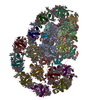
|
|---|---|
| 1 |
|
- Components
Components
-Chlorophyll a-b binding protein, ... , 6 types, 12 molecules UVW152637489
| #1: Protein | Mass: 28403.947 Da / Num. of mol.: 3 / Source method: isolated from a natural source / Source: (natural)  Physcomitrium patens (plant) / References: UniProt: A9RT62 Physcomitrium patens (plant) / References: UniProt: A9RT62#2: Protein | Mass: 25931.562 Da / Num. of mol.: 2 / Source method: isolated from a natural source / Source: (natural)  Physcomitrium patens (plant) / References: UniProt: A0A2K1JLZ3 Physcomitrium patens (plant) / References: UniProt: A0A2K1JLZ3#3: Protein | Mass: 29036.998 Da / Num. of mol.: 2 / Source method: isolated from a natural source / Source: (natural)  Physcomitrium patens (plant) / References: UniProt: A9TJ06 Physcomitrium patens (plant) / References: UniProt: A9TJ06#4: Protein | Mass: 34673.801 Da / Num. of mol.: 2 / Source method: isolated from a natural source / Source: (natural)  Physcomitrium patens (plant) / References: UniProt: A0A2K1IB10 Physcomitrium patens (plant) / References: UniProt: A0A2K1IB10#5: Protein | Mass: 28818.881 Da / Num. of mol.: 2 / Source method: isolated from a natural source / Source: (natural)  Physcomitrium patens (plant) / References: UniProt: A0A2K1K0E4 Physcomitrium patens (plant) / References: UniProt: A0A2K1K0E4#20: Protein | | Mass: 33175.734 Da / Num. of mol.: 1 / Source method: isolated from a natural source / Source: (natural)  Physcomitrium patens (plant) / References: UniProt: A0A2K1KKR9 Physcomitrium patens (plant) / References: UniProt: A0A2K1KKR9 |
|---|
-Photosystem I P700 chlorophyll a apoprotein ... , 2 types, 2 molecules AB
| #6: Protein | Mass: 83226.508 Da / Num. of mol.: 1 / Source method: isolated from a natural source / Source: (natural)  Physcomitrium patens (plant) / References: UniProt: Q8MFA3, photosystem I Physcomitrium patens (plant) / References: UniProt: Q8MFA3, photosystem I |
|---|---|
| #7: Protein | Mass: 82447.750 Da / Num. of mol.: 1 / Source method: isolated from a natural source / Source: (natural)  Physcomitrium patens (plant) / References: UniProt: Q8MFA2, photosystem I Physcomitrium patens (plant) / References: UniProt: Q8MFA2, photosystem I |
-Protein , 2 types, 2 molecules CL
| #8: Protein | Mass: 8781.153 Da / Num. of mol.: 1 / Source method: isolated from a natural source / Source: (natural)  Physcomitrium patens (plant) / References: UniProt: Q6YXQ2, photosystem I Physcomitrium patens (plant) / References: UniProt: Q6YXQ2, photosystem I |
|---|---|
| #17: Protein | Mass: 23530.299 Da / Num. of mol.: 1 / Source method: isolated from a natural source / Source: (natural)  Physcomitrium patens (plant) / References: UniProt: A0A7I4A0Q6 Physcomitrium patens (plant) / References: UniProt: A0A7I4A0Q6 |
-Photosystem I reaction center subunit ... , 8 types, 8 molecules DEFGHIJM
| #9: Protein | Mass: 22183.309 Da / Num. of mol.: 1 / Source method: isolated from a natural source / Source: (natural)  Physcomitrium patens (plant) / References: UniProt: A9REG3 Physcomitrium patens (plant) / References: UniProt: A9REG3 |
|---|---|
| #10: Protein | Mass: 13919.796 Da / Num. of mol.: 1 / Source method: isolated from a natural source / Source: (natural)  Physcomitrium patens (plant) / References: UniProt: A0A2K1IHL7 Physcomitrium patens (plant) / References: UniProt: A0A2K1IHL7 |
| #11: Protein | Mass: 26112.318 Da / Num. of mol.: 1 / Source method: isolated from a natural source / Source: (natural)  Physcomitrium patens (plant) / References: UniProt: A0A2K1IN36 Physcomitrium patens (plant) / References: UniProt: A0A2K1IN36 |
| #12: Protein | Mass: 16231.396 Da / Num. of mol.: 1 / Source method: isolated from a natural source / Source: (natural)  Physcomitrium patens (plant) / References: UniProt: A0A2K1JC42 Physcomitrium patens (plant) / References: UniProt: A0A2K1JC42 |
| #13: Protein | Mass: 14506.459 Da / Num. of mol.: 1 / Source method: isolated from a natural source / Source: (natural)  Physcomitrium patens (plant) / References: UniProt: A0A2K1JDR4 Physcomitrium patens (plant) / References: UniProt: A0A2K1JDR4 |
| #14: Protein/peptide | Mass: 4017.787 Da / Num. of mol.: 1 / Source method: isolated from a natural source / Source: (natural)  Physcomitrium patens (plant) / References: UniProt: Q6YXR3 Physcomitrium patens (plant) / References: UniProt: Q6YXR3 |
| #15: Protein/peptide | Mass: 4597.460 Da / Num. of mol.: 1 / Source method: isolated from a natural source / Source: (natural)  Physcomitrium patens (plant) / References: UniProt: Q6YXM2 Physcomitrium patens (plant) / References: UniProt: Q6YXM2 |
| #18: Protein/peptide | Mass: 3412.051 Da / Num. of mol.: 1 / Source method: isolated from a natural source / Source: (natural)  Physcomitrium patens (plant) / References: UniProt: Q6YXK4 Physcomitrium patens (plant) / References: UniProt: Q6YXK4 |
-Photosystem I subunit ... , 2 types, 2 molecules KO
| #16: Protein | Mass: 13278.444 Da / Num. of mol.: 1 / Source method: isolated from a natural source / Source: (natural)  Physcomitrium patens (plant) / References: UniProt: A0A2K1KU02 Physcomitrium patens (plant) / References: UniProt: A0A2K1KU02 |
|---|---|
| #19: Protein | Mass: 15393.113 Da / Num. of mol.: 1 / Source method: isolated from a natural source / Source: (natural)  Physcomitrium patens (plant) / References: UniProt: A0A2K1JDF1 Physcomitrium patens (plant) / References: UniProt: A0A2K1JDF1 |
-Sugars , 2 types, 5 molecules 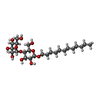


| #31: Sugar | ChemComp-LMT / #32: Sugar | ChemComp-DGD / | |
|---|
-Non-polymers , 11 types, 363 molecules 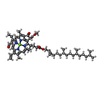

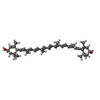
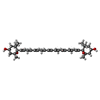
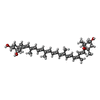



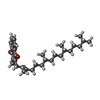












| #21: Chemical | ChemComp-CHL / #22: Chemical | ChemComp-CLA / #23: Chemical | ChemComp-LUT / ( #24: Chemical | ChemComp-XAT / ( #25: Chemical | ChemComp-NEX / ( #26: Chemical | ChemComp-LHG / #27: Chemical | ChemComp-BCR / #28: Chemical | ChemComp-LMG / #29: Chemical | #30: Chemical | #33: Water | ChemComp-HOH / | |
|---|
-Details
| Has ligand of interest | Y |
|---|---|
| Has protein modification | Y |
-Experimental details
-Experiment
| Experiment | Method: ELECTRON MICROSCOPY |
|---|---|
| EM experiment | Aggregation state: PARTICLE / 3D reconstruction method: single particle reconstruction |
- Sample preparation
Sample preparation
| Component | Name: photosystem I from Physcomitrium patens / Type: COMPLEX / Entity ID: #1-#20 / Source: NATURAL |
|---|---|
| Source (natural) | Organism:  Physcomitrium patens (plant) Physcomitrium patens (plant) |
| Buffer solution | pH: 6.5 |
| Specimen | Embedding applied: NO / Shadowing applied: NO / Staining applied: NO / Vitrification applied: YES |
| Vitrification | Cryogen name: ETHANE |
- Electron microscopy imaging
Electron microscopy imaging
| Experimental equipment |  Model: Titan Krios / Image courtesy: FEI Company |
|---|---|
| Microscopy | Model: FEI TITAN KRIOS |
| Electron gun | Electron source: OTHER / Accelerating voltage: 300 kV / Illumination mode: OTHER |
| Electron lens | Mode: OTHER / Nominal defocus max: 2500 nm / Nominal defocus min: 1500 nm |
| Image recording | Electron dose: 60 e/Å2 / Film or detector model: GATAN K2 SUMMIT (4k x 4k) |
- Processing
Processing
| EM software | Name: PHENIX / Version: 1.19.2_4158: / Category: model refinement | ||||||||||||||||||||||||
|---|---|---|---|---|---|---|---|---|---|---|---|---|---|---|---|---|---|---|---|---|---|---|---|---|---|
| CTF correction | Type: PHASE FLIPPING AND AMPLITUDE CORRECTION | ||||||||||||||||||||||||
| 3D reconstruction | Resolution: 2.87 Å / Resolution method: FSC 0.143 CUT-OFF / Num. of particles: 144586 / Symmetry type: POINT | ||||||||||||||||||||||||
| Refine LS restraints |
|
 Movie
Movie Controller
Controller








 PDBj
PDBj





















